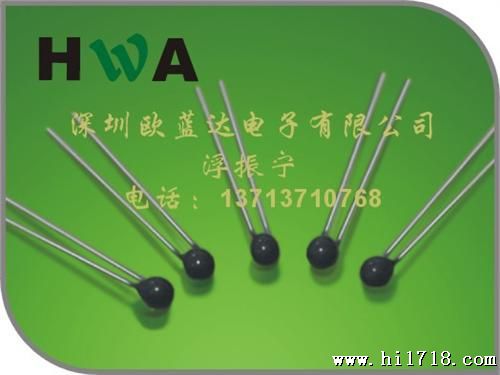-
图文详情
-
产品属性
-
相关推荐
NTC热敏电阻器系由特殊配置的金属氧化物陶瓷材料制成,它可用来抑制高的突波电流。相对于受保护电路,热敏电阻器具有较高的电阻。因此会抑制突波电流约1~2秒,在这一段时间内热敏电阻的电阻将因温度升高而下降,直至热敏电阻两端压降到可被忽略的电阻值为止。如图A以电源供应器为例, 在电源开的瞬间,电容器一般阻抗极低,桥式整流器通常承受很大的电流,热敏电阻器特别使用于保护电源供应器。
Shanghai mec electronic NTC Thermistor devices are made of a specially formulated metal oxide ceramic material which is capable of suppressing high inrush current surges.
Thermistor devices, being of relatively high resistance, shall limit the inrush current for 1~2 seconds during which time the device decreased in resistance substantially to a point where its voltage drop is negligible .The devices are especially useful in power supplies (see Fig A) because of the extremely low impedance of the capacitor being charged, of which the bridge is ususlly subjected to an exceedingly high current surge at turnon point.
特征
●有效抑止突波电流。
●稳定状态下功率损耗极小(通常仅有1W或小于50W)。
●热及电特性稳定性高。
●宽广的电性规格可供选择。
FEATURES
●High inrush current restriction effect
●Small power loss in stationary state
●(Normally less than 50W power)
●High thermal and electrical stability.
●Wide selection of electrical performances
应用概述
如图B所示,将一NTC热敏电阻与一白热灯丝串联时,可以消除突波电流。若一只NTC热敏电阻无法提供足够之突流限制功能时,二只或更多的热敏电阻可用于串联电路上或供应电路的各个分路上(如图A)。但要注意的是NTC热敏电阻,不可并联于电路上,因为其中一只NTC就可能会传导几乎所有的电流。热敏电阻用于图A所示AC电路的A1或A2处,或是DC电路D1或D2处。
在设计上,当电路刚被打开的瞬间,NTC热敏电阻的阻值高于电路上所有白热灯丝的总电阻值。当电流开始通过时,热敏电阻随时产生「自然」现象,并在1到2秒内,阻值会降到几可忽略。以同样的构想来看电动马达的突波电流,亦可以被抑制到限度。图C表示应用热敏电阻保护直流马达前后突波电流波形的差异。
APPLICATION
As shown in Fig.B, the current surge can be eliminated by placing a NTC thermistor in series with a filament string. Yet, if the resistance of one NTC thermistor does not provide sufficient inrush current limiting functions for your applicantion, 2 or more may be used in series or in separate legs of the supply circuit (Fig.A). Be noticed, the thermistor can not be used in parallel since one unit will tend to conduct nearly all the current available. Thus, thermistor may be used in the AC (point A1or A2)or the DC (point D1or D2) locations in the circuit. (see Fig.A)
The resistance of NTC thermistor is designed higher than the total resistance of NIC thermistor is designed higher than the total resistance of filaments when thermistor shall immediately self-heat. Then, in 1~2 seconds, its resistance will be reduced to a minimum and become insignificant to the total resistance of a circuit. With the same concept, current surges in electric motors can be held to minimum. Fig.C shows a typical DC motor s turn on surge before and after the application of a thermistor to the circuit
选用原则
1.热敏电阻器的工作电流>实际电源回路的工作电流
2.热敏电阻器的标称电阻值
R≥ 式中E为线路电压 l m为浪涌电流
对于转换电源、逆变电源、开关电源、
UPS电源l m=100倍工作电流
对于灯丝、加热器等回路l m=30倍工作电流
1.Maximum operating current >Actual operating current in the power loop
2.Reted zero power resistance at 25℃
of which, E: loop voltage, lm: Surge current.
For conversion power, reversion power, switch power,
UPS power, lm=100 times. operating current
For filament, heater, lm=30 times operating current
电压电流特性
当NTCR热敏电阻在小电流下工作时(如图F),由于功率太底,其电阻保持固定而表现线性关系(符合欧姆定律V/R=1)。如果电流增加,NTC热敏电阻就会产生焦耳效应(P =V×1)而使自己发热,其电阻值随即减小表现「电流增加,电压下降」的状态。
When operating low current (see fig.F), due to very low power is unable to make the NTC thermistor self-heated, so its resistance value is thus maintained constant and displayed with a linear curve (in conformity with ohm-law V/R=1).If the current is increased, the NTC thermistor will follow Joule-efficiency(P= V×1) and make itself self-heated that results in a resistace value decreasing and thus displays with a status of voltage descending while current increased.
(如图F),说明NTC元件与环境达成热平衡所需的时间,主要决定于材料热容量(G)及散热系数(δ)。当元件温度由T1降到T0,则可得到下列平衡式:
-HdT=δ(T-T0)dt 其中-HdT=元件热损失
δ(T-T0)dt:元件散热量
积分后可得温度与时间关系式T-T1= (T0-T1)×e-t/t
其中τ=H/δ
As shown in fig.G which explains the time needed to reach thermal equilibrium of NTC components with the enviroment. This characteristic depends on two important parameters. If a step change in temperature is applied to a component e.g. form high (T1) to low (T0) temperature, the energy lost (δ(T0-T1)dt) by the component (-HdT) is equal to the energy dissipated by it.
-HdT=δ(T-T0)dt
This equation yields: T-T1= (T0-T1)×e-t/t
τ=H/δ

